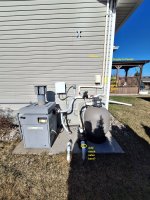Hi everyone, first post here.
I would like to some opinions on where the ideal locations would be to install check valves on my pool plumbing. I am trying to solve the following 2 issues:
1- It's challenging to blow out my solar panel heater lines before winter. I'm thinking of adding a union somewhere to make it easier to blow out the lines. When doing research, I noticed most installs have check valves on the solar panel plumbing. Is it best to have one on the supply or return pipe?
2- The pump return line to my pool is really long. The pump loses its prime easily after it's been turned off. Would a check valve installed right after the pump help solve this issue?
I would like to some opinions on where the ideal locations would be to install check valves on my pool plumbing. I am trying to solve the following 2 issues:
1- It's challenging to blow out my solar panel heater lines before winter. I'm thinking of adding a union somewhere to make it easier to blow out the lines. When doing research, I noticed most installs have check valves on the solar panel plumbing. Is it best to have one on the supply or return pipe?
2- The pump return line to my pool is really long. The pump loses its prime easily after it's been turned off. Would a check valve installed right after the pump help solve this issue?


